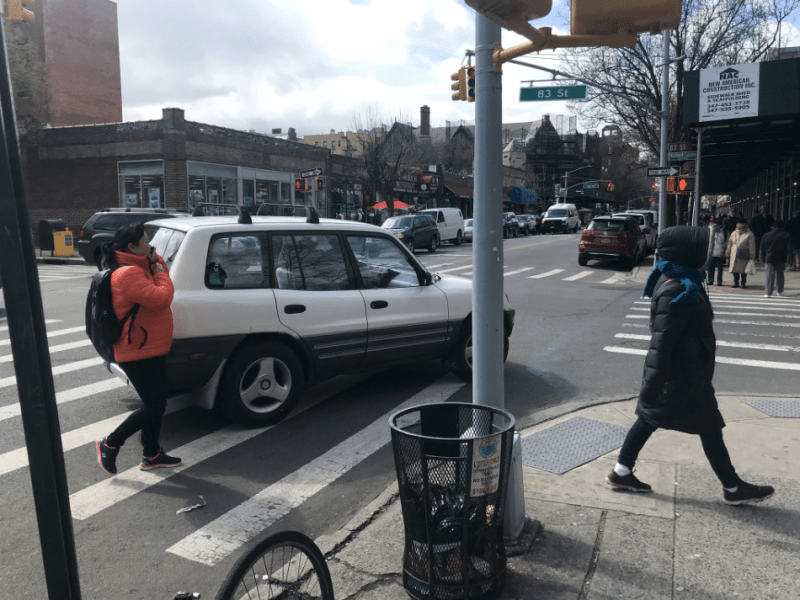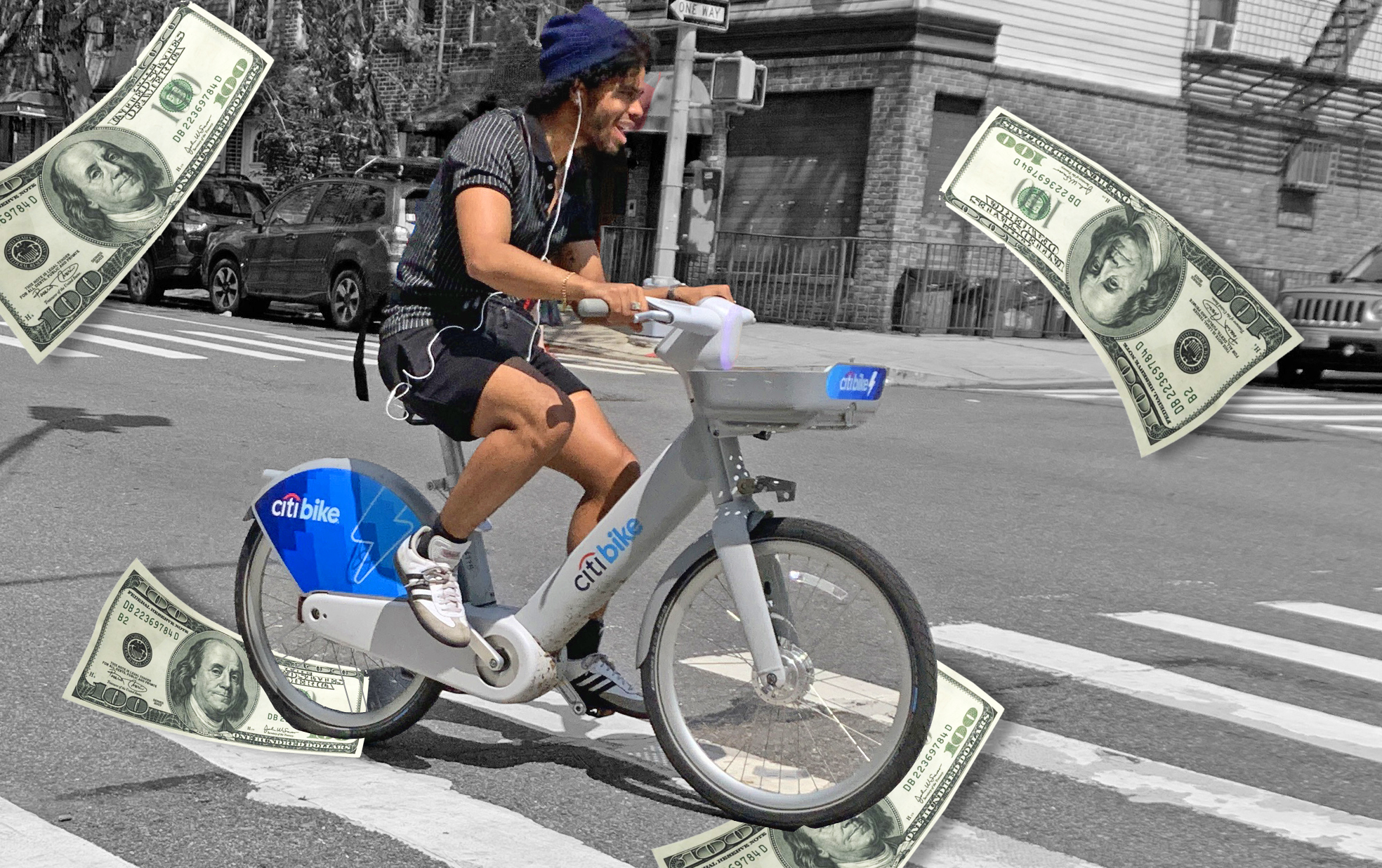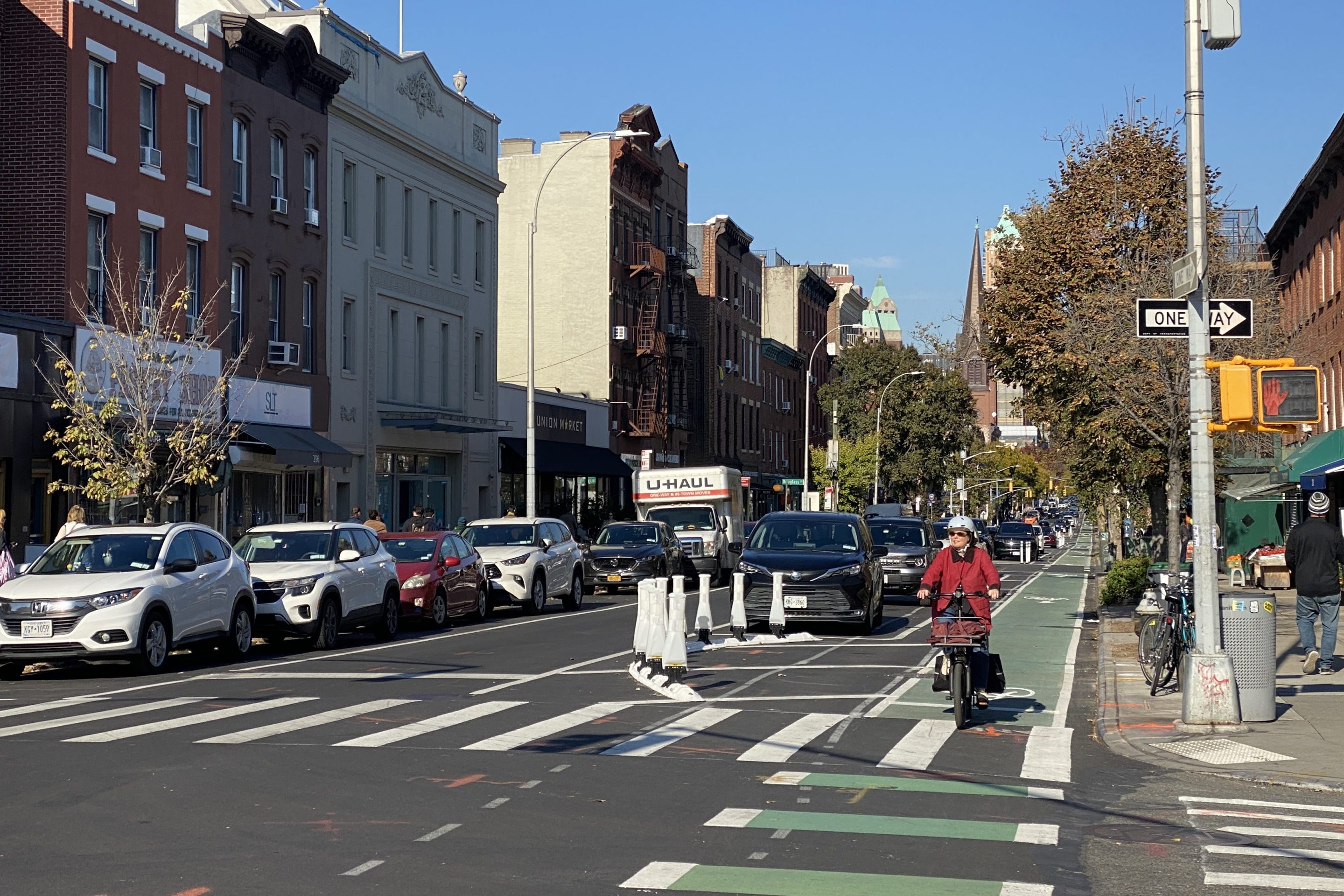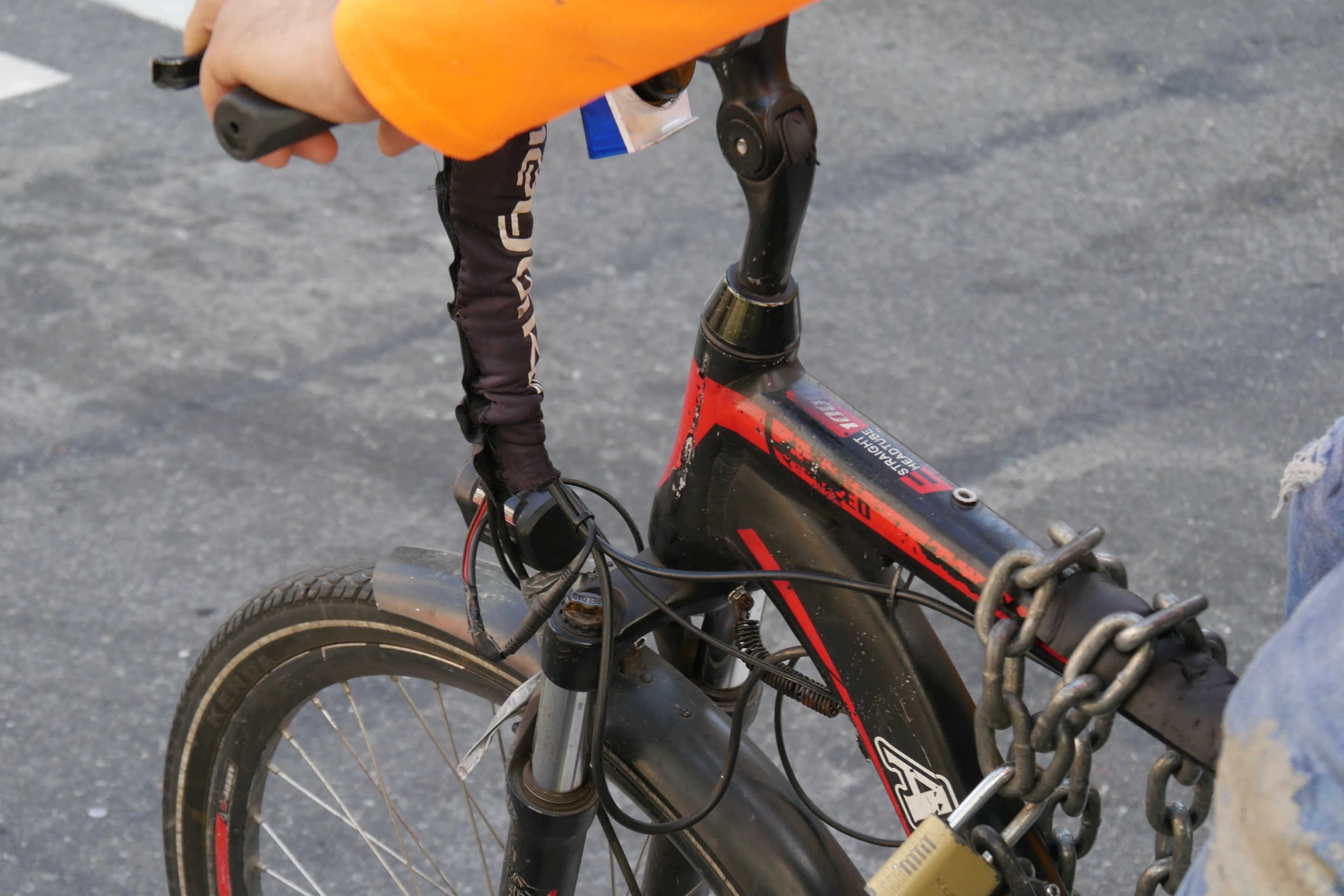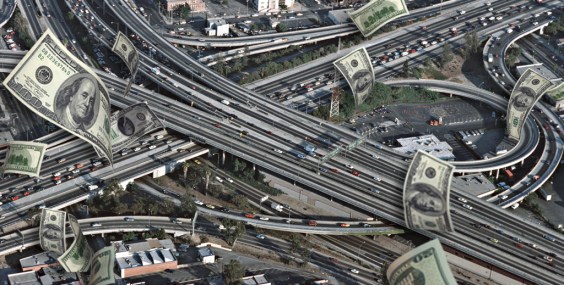Driving is so hard-wired into American culture, life and institutions, that it's hard to account for all the ways it is subsidized, preferenced or otherwise favored. But Greg Shill, a law professor at University of Iowa, attempted it anyway.
In a new paper, he lists all the ways the legal system puts its thumb on the scale for drivers to the detriment of everyone else: transit users, cyclists and pedestrians.
"Rules from virtually every field of law that codify subsidies for driving, including dangerous driving, should be repealed," Shill writes. "These laws are not the root cause of automobile supremacy, but they armor it in law and give it agency of its own."
How many areas of law? Let Shill count the ways:
#1. Traffic Laws Soft-Peddle Very Dangerous Behavior
Speeding kills 10,000 Americans annually. But while it's technically illegal, the offense enforced arbitrarily and half-heartedly.
For example, in practice, speeding rules are not enforced unless the violation is in excess of 10 mph over the limit. This is an example of what's called in legal terms "an insincere rule," he says, a rule that practically mandates something other than what it states. That approach to speeding "fosters a creeping normalization" of what is in fact a very dangerous activity, he writes.
In addition, other dangerous behavior, like failing to yield to pedestrians is almost never enforced. Shill cites a Wisconsin study showing drivers only yielded to pedestrians 16 percent of the time, indicating that if cops wanted to, they could spend their time doing nothing else but writing failure-to-yield tickets.
#2. Land Use Laws Favor Sprawl
Zoning laws such as single-family only land uses and minimum lot sizes have served to spread the distance between where people live and where they want to go, forcing them into lifestyles that are almost totally dependent on driving. In addition, zoning laws frequently restrict housing density — a more walkable form of land use — and limit mixed-use buildings, which blend retail and residential.
As a result walkable housing and retail are effectively outlawed in much of America.
#3. Legal Parking Requirements Subsidize Driving
"Over the past 100 years," Shill writes, "it has been the undeclared first principle of U.S. transportation policy that individuals should be able to travel door-to-door in private vehicles at no cost, beyond the expenses of operating one’s own car. "
Minimum parking requirements are a key part of that. A ubiquitous part of zoning law, they require a fixed number of parking spaces near every building type. Usually, these parking spaces are provided for free to users, but that doesn't mean they don't cost money. Some studies have estimated they add as much as $225to an apartment's rent.
These rules have led to massive amounts of land being consumed by parking. For example, by some estimates14 percent of LA County's land area is consumed by parking.
In addition, to parking requirements, many cities provide free on-street parking, or undercharge for it. Even ultra-liberal, transit friendly Cambridge, Massachusetts "sells car storage for $2.08 a month" through its residential permitting program, Shill writes.
#4. Emissions Laws Exempt 'Light Trucks'
Environmental regulations also serve to subsidize driving in a variety of perverse ways. Shill singles out the exemption from fuel economy standards for "light trucks" i.e. SUVs. This encouraged car makers to sell pickup trucks and SUVs, which now make up about 65 percent of new car sales. As a result, they have wiped outall the efficiency gains made by cars over the last few decades.
In addition, SUVs in particular tend to be deadly for pedestrians. The National Highway Transportation Safety Administration estimates they are two to three times more likely to kill a pedestrian in a collision than a sedan.
#5. Emissions Laws Ignore the Environmental Costs of Roadbuilding
The EPA regulates vehicle emissions — although, as we've covered, not every effectively. At the same time, the EPA ignores the high environmental cost of building the roads themselves. The U.S. added an average of 31,000 highway lane miles per year over the last decade, Shill reports adding about 109 million metric tons of carbon dioxide to the air annually just from the construction. The social cost of that, using standard formulas, is about $4 billion, he says. EPA doesn't do anything about it.
#6. Vehicle Safety Regulations Ignore Pedestrians
The U.S. imposes all kinds of safety regulations on vehicle manufacturers such as airbags, seatbelts and crumple zones. But, so far, these regulations have completely ignored vulnerable road users: pedestrians and cyclists.
Safety groups like the Insurance Institute for Highway Safety, Shill said, "have for decades only considered the crashworthiness of vehicles for occupants of the vehicle being rated, again ignoring potential impacts on pedestrians and other vehicles."
Meanwhile, the United Nations urges national governments to use regulations to protect pedestrians, who make up 16 percent of total U.S. traffic deaths — a portion that is growing as cars become safer and safer for their occupants and more dangerous for everyone else. Forty-four nations have adopted the guidelines. Late in the Obama Administration, U.S. safety regulators moved to begin considering impacts to pedestrians, but the effort has not been continuedby the Trump administration.
#7. Vehicle Safety Regulations Allow Unsafe Aftermarket Vehicle Modifications
Vehicle regulations also inexplicably ignore a whole range of aftermarket modifications that can worsen safety, especially for vulnerable users.
Most notably, perhaps, they allow drivers — especially drivers of pickups and SUVs — to affix "bull bars," metal reinforcement rods, to the front ends of their vehicles. These have shown to be dangerous to both drivers and pedestrians. They are especially dangerous to children. Child pedestrians hit by a car with bull bars at 10 to 15 times more likely to be killed, one study found.
They are banned in the U.K. and in some other countries, but in the U.S. they are basically unregulated. In fact, many police departments use taxpayer dollars to purchase them for patrol vehicles.
#8. Insurance Law Limits Payouts to Pedestrians
Insurance law also fails pedestrians in a couple of ways.
For one thing, premiums are fixed, regardless of how many miles a driver drives — a perverse form of pricing that incentivizes more driving, which leads to more crashes. Studies have estimatedthat a pay-as-you-go auto insurance rate would reduce driving 6 to 10 percent.
In addition, states' insurance laws fail pedestrians by requiring only relatively low bodily injury coverage. Shill writes:
The modal minimum amount of bodily injury coverage required by states is $25,000. The steepest requirement, $50,000, only applies in two of the nation’s least populated states, Alaska and Maine. The lowest is zero, which applies in Florida and New Hampshire.
In three of the nation’s five most populous states—California, Florida, and Pennsylvania, with nearly 75 million residents among them — the mandatory level of insurance for bodily injury is unusually low, between zero and $15,000.
"Most states," Shill continues. "formally prioritize third parties — pedestrians, motorists, and property owners who are harmed by the insured’s actions. In no state is the scheme designed with anything resembling a goal of making vulnerable road users whole after being run over by a car."
#9. Tax Law Subsidizes Sprawl
U.S. tax law also upholds the supremacy of driving, mostly through the mortgage interest deduction, says Shill. This tax benefit privileges homeownership over renting, helping fuel sprawl and car dependence.
#10. Tort Law Protects Dangerous Drivers
Tort law — which allows injured parties to sue for relief — also prevents injured pedestrians and cyclists from winning full restitution in a couple of ways, Shill writes.
"Courts restrict strict liability to activities that are both ultrahazardous and uncommon," he writes.
But, of course, many driving behaviors are ultra-hazardous but also extremely common.
"A superior legal approach to our present one would rely on the dangerousness requirement alone," he writes.
#11. Contract Law Freezes Out Pedestrians
Pedestrians, when they are injured in a collision that might be due to a vehicle defect, don't have standing because they do not have "privity," meaning they didn't enter into a contract with the car maker, like the buyer did, Shill explains.
"Thus, under a strict reading of this rule, an innocent bystander would be unable to sue an automobile manufacturer in contract," Shill writes. "The lack of privity defense has been criticized for removing potential relief for innocent bystanders, who do not have any way of preventing or avoiding the risks caused by unsafe products."
#12. Criminal Law Rarely Punishes Dangerous Drivers
People who kill or injury pedestrians with vehicles are almost never charged criminally and convicted even more rarely, Shill writes.
A 2015 study [PDF] by the New York-based advocacy group Transportation Alternatives found that 99 percent of drivers involved in hit-and-run crashes were not charged by New York City's five district attorneys.
The charge of vehicular homicide can help some pedestrians get justice. But juries are hesitant to convict of even lesser charges like involuntary manslaughter, Shill says.
